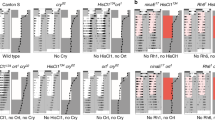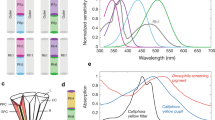Abstract
The role of histamine as a fast neuro-transmitter of imaginai insect photoreceptors is firmly established. In adult Drosophila, histamine is also found in mechanosensory receptors of cuticular hair sensilla and in a small number of nonreceptor neurons in head and body ganglia. Here we investigate the function of histamine by immunohistochemical and behavioral analysis of mutants deficient in the hdc gene that codes for histidine decarboxylase. The allele hdc JK910 appears to be a null mutation, as histamine immunoreactivity is almost entirely eliminated. Homozygous flies are blind in various behavioral paradigms. Mutant larvae, on the other hand, show normal photokinetic responses. Thus, adult Drosophila photoreceptors most likely utilize only a single substance, histamine, as a neurotransmitter, whereas larval photoreceptors apparently employ a different transmitter. With the alleles hdc p211, hdc p217, and hdc p218, variable amounts of histamine are found in photoreceptors and mechanoreceptors, but no histamine could be detected in any of the nonreceptor neurons. These mutants show various degrees of visual and mechanosensory impairment, as determined by quantitative behavioral assays. We conclude that histamine is required for normal function of cuticular hair sensilla and for efficient grooming of the body surface. Thus, in Drosophila, histamine represents a major functional neurotransmitter for mechanosensory receptors.
Similar content being viewed by others
Abbreviations
- ERG :
-
electroretinogram
- WT :
-
wild type
References
Ashburner M (1989) Drosophila: a laboratory manual. Cold Spring Harbor Laboratory Press, Cold Spring Harbor
Battelle BA, Calman BG, Andrews AW, Grieco FD, Mleziva MB, Callaway JC, Stuart AE (1991) Histamine: a putative afferent neurotransmitter in Limulus eyes. J Comp Neurol 305: 527–542
Bayer TA, McClintock TS, Grünert U, Ache BW (1989) Histamine-induced modulation of olfactory receptor neurones in two species of lobster, Panulirus argus and Homarus americanus. J Exp Biol 145: 133–146
Benzer S (1967) Behavioral mutants of Drosophila isolated by countercurrent distribution. Proc Natl Acad Sci USA 58: 1112–1119
Buchner E (1976) Elementary movement detectors in an insect visual system. Biol Cybern 24: 85–101
Buchner E, Buchner S, Crawford G, Mason WT, Salvaterra PM, Satelle DB (1986) Choline acetyltransferase-like immunoreactivity in the brain of Drosophila melanogaster. Cell Tissue Res 246: 57–62
Buchner E, Buchner S, Burg MG, Hofbauer A, Pak WL, Pollack I (1993) Histamine is a major mechanosensory neurotransmitter candidate in Drosophila melanogaster. Cell Tissue Res 273: 119–125
Bülthoff H, Götz KG, Herre M (1982) Recurrent inversion of visual orientation in the walking fly, Drosophila melanogaster. J Comp Physiol 148: 471–481
Burg MG, Wu C-F (1986) Differentiation and central projections of peripheral sensory cells with action potential block in Drosophila mosaics. J Neurosci 6: 2968–2976
Burg MG, Wu C-F (1989) Central projections of peripheral mechanosensory cells with increased excitability in Drosophila mosaics. Dev Biol 131: 505–514
Burg MG, Sarthy PV, Koliantz G, Pak WL (1993) Genetic and molecular identification of a Drosophila histidine decarboxylase gene required in photoreceptor transmitter synthesis. EMBO J 12: 911–919
Chevalier RL (1969) The fine structure of campaniform sensilla on the halteres of Drosophila melanogaster. J Morphol 128: 443–464
Clairborne BJ, Selverston AI (1984) Histamine as a neurotransmitter in the stomatogastric nervous system of the spiny lobster. J Neurosci 4: 708–721
Cole ES, Palka J (1982) The pattern of campaniform sensilla on the wing and haltere of Drosophila melanogaster and several of it's homeotic mutants. J Embryol Exp Morphol 71: 41–61
Corfas G, Dudai Y (1989) Habituation and dishabituation of a cleaning reflex in normal and mutant Drosophila. J Neurosci 9:pp 56–62
Corfas G, Dudai Y (1990) Adaptation and fatigue of a mechanosensory neuron in wildtype Drosophila and in memory mutants. J Neurosci 10: 490–499
Dominguez M, Campuzano S (1993) asense, a member of the Drosophila achaete-scute complex, is a proneural and neural differentiation gene. EMBO J 12: 2049–2060
Götz K (1980) Visual guidance in Drosophila. In: Siddiqi O, Babu P, Hall LM, Hall JC (eds) Development and neurobiology of Drosophila. Plenum, New York, pp 391–407
Gordesky-Gold B, Warrick JM, Bixler A, Beasley JE, Tompkins L (1995) Hypomorphic mutations in the larval photokinesis A (IphA) gene have stage-specific effects on visual system function in Drosophila melanogaster. Genetics 139: 1623–1629
Hardie RC (1987) Is histamine a neurotransmitter in insect photoreceptors? J Comp Physiol 161: 201–213
Hardie RC (1988) Effects of antagonists on putative histamine receptors in the first visual neuropile of the housefly (Musca domestica). J Exp Biol 138: 221–241
Hardie RC (1989a) Neurotransmitters of the compound eye. In: Stavenga DG, Hardie RC (eds) Facets of vision. Springer, Berlin Heidelberg New York, pp 235–256
Hardie RC (1989b) A histamine-activated chloride channel involved in neurotransmission at a photoreceptor synapse. Nature 339: 704–706
Heisenberg M, Götz KG (1975) The use of mutations for the partial degradation of vision in Drosophila melanogaster. J Comp Physiol 98: 217–241
Heisenberg M, Buchner E (1977) The role of retinula cell types in visual behavior of Drosophila melanogaster. J Comp Physiol 117: 127–162
Hill SJ (1990) Distribution, properties and functional characteristics of three classes of histamine receptor. Pharmacol Rev 42: 45–83
Nässel DR, Holmquist MH, Hardie RC, Häkanson R, Sundler F (1988) Histamine-like immunoreactivity in photoreceptors of the compound eyes and ocelli of flies Calliphora erythrocephala, Musca domestica. Cell Tissue Res 253: 639–646
Nässel DR, Pirvola U, Panula P (1990) Histamine like immunoreactive neurons innervating putative neurohaemal areas and central neuropil in the thoraco-abdominal ganglia of the flies Drosophila and Calliphora. J Comp Neurol 297: 525–536
Nässel DR, Elekes K (1992) Aminergic neurons in the brain of blowflies and Drosophila: dopamine- and tyrosine hydroxylaseimmunoreactive neurons and their relationship with putative histaminergic neurons. Cell Tissue Res 267: 147–167
Orona E, Batteile B-A, Ache BW (1990) Immunohistochemical and biochemical evidence for the putative inhibitory neurotransmitters histamine and GABA in lobster olfactory lobes. J Comp Neurol 294: 633–646
Panula P, Pirvola U, Auvinen S, Airaskinen MS (1989) Histamine immunoreactive nerve fibers in the rat brain. Neuroscience 28: 585–610
Phillis WR, Bramlage AT, Wotus C, Whittaker L, Gramates LS, Seppala D, Farahanchi F, Caruccio P, Murphey RK (1993) Isolation of mutations affecting neural circuitry required for grooming behavior in Drosophila melanogaster. Genetics 133: 581–592
Pirvola U, Tuomisto L, Yamatodani A, Panula P (1988) Distribution of histamine in the cockroach brain and visual system: an immunocytochemical and biochemical study. J Comp Neurol 276: 514–526
Pollack I, Hofbauer A (1991) Histamine-like immunoreactivity in the visual system and brain of Drosophila melanogaster. Cell Tissue Res 266: 391–398
Roeder T, Voßfeldt R, Gewecke M (1993) Pharmacological characterization of the locust neuronal 3H-mianserin binding site, a putative histamine receptor. Comp Biochem Physiol 106C: 503–507
Sarthy PV (1991) Histamine: a neurotransmitter candidate for Drosophila photoreceptors. J Neurochem 57: 1757–1768
Schlemermeyer E, Schütte M, Ammermüller J (1989) Immunohistochemical and electrophysiological evidence that locust ocellar photoreceptors contain and release histamine. Neurosci Lett 99: 73–78
Schmid A, Duncker M (1993) On the function of histamine in the central nervous system of arthropods. Acta Biol Hung 44: 67–75
Simmons PJ, Hardie RC (1988) Evidence that histamine is a neurotransmitter of photoreceptors in the locust ocellus. J Exp Biol 138: 205–219
Skiebe P, Corette BJ, Wiese K (1990) Evidence that histamine is the inhibitory transmitter of the auditory interneuron ON1 of crickets. Neurosci Lett 116: 361–366
Strauss R, Heisenberg M (1993) A higher control center of locomotor behavior in the Drosophila brain. J Neurosci 13: 1852–1861
Sturtevant AH (1970) Studies on the bristle pattern of Drosophila. Dev Biol 21: 48–61
Szebenyi AL (1969) Cleaning behavior in Drosophila melanogaster. Anim Behav 17: 641–651
Usui-Ishihara A, Ghysen A, Kimura KI (1995) Peripheral axonal pathway and cleaning behavior are correlated in Drosophila microchaetes. Dev Biol 167: 398–401
Vandervorst P, Ghysen A (1980) Genetic control of sensory connections in Drosophila. Nature 286: 65–67
Wada H, Inagaki N, Yamatodani A, Watanabe T (1991) Is the histaminergic neuron system a regulatory center for wholebrain activity? Trends Neurosci 14: 415–418
Yang QZ, Hatton GI (1994) Histamine mediates fast synaptic inhibition of rat supraoptic oxytocin neurons via chloride conductance activation. Neuroscience 62: 955–964
Yasuyama K, Kitamoto T, Salvaterra PM (1995) Localization of choline acetyltransferase-expressing neurons in the larval visual system of Drosophila melanogaster. Cell Tissue Res 282: 193–202
Zalokar M (1947) Anatomie du thorax de Drosophila melanogaster. Rev Suisse Zool 54: 17–53
Author information
Authors and Affiliations
Rights and permissions
About this article
Cite this article
Melzig, J., Buchner, S., Wiebel, F. et al. Genetic depletion of histamine from the nervous system of Drosophila eliminates specific visual and mechanosensory behavior. J Comp Physiol A 179, 763–773 (1996). https://doi.org/10.1007/BF00207355
Accepted:
Issue Date:
DOI: https://doi.org/10.1007/BF00207355




